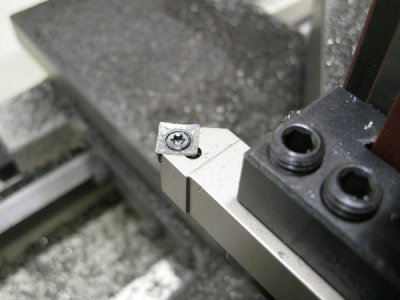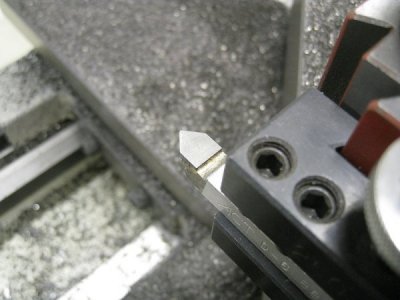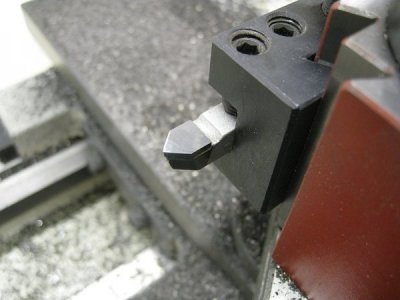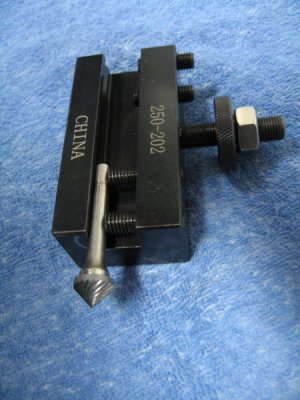Mike, I think your knife tool has back rake on it doesn't it? That means you likely are not cutting too far from the tip are you (back to the off center issue)? Do you spin the post and plunge through the chamfer rather than side cutting?
-
Welcome back Guest! Did you know you can mentor other members here at H-M? If not, please check out our Relaunch of Hobby Machinist Mentoring Program!
You are using an out of date browser. It may not display this or other websites correctly.
You should upgrade or use an alternative browser.
You should upgrade or use an alternative browser.
Grinding a HSS Chamfering Tool?
- Thread starter Alan H.
- Start date
- Joined
- Sep 29, 2014
- Messages
- 2,102
Grind a 90 Deg. included point, it will do ID and OD when held axially.
I use a square insert tool on manual lathes and program the chamfers with NC lathes.
Like so
https://images-na.ssl-images-amazon.com/images/I/31Exo7FmJLL.jpg
I use a square insert tool on manual lathes and program the chamfers with NC lathes.
Like so
https://images-na.ssl-images-amazon.com/images/I/31Exo7FmJLL.jpg
- Joined
- Dec 20, 2012
- Messages
- 9,422
I don't worry too much about cutting on center height when chamfering. I can get away with that because I tend to use larger relief angles than most folks do. I also slow the lathe down a bit before cutting. And yes, I bring the side of the tool into contact and feed in with the cross slide. Accordingly, the segment of the cutting edge is changing elevation as I go in. I have no chatter and the cut is done inside of a second or two at most.
- Joined
- Nov 27, 2012
- Messages
- 7,912
Check out the tool that Tom Lipton (Ox Tools) grinds, Stefan Gotteswinter also uses the same grind. It allows you to face with it also. It's really only for OD chamferring but if the hole is large enough & if you grind enough clearance you can use it for ID chamfering as well. You can also raise the cutting height/tool for ID chamfering for more clearance. EDIT: Didn't notice but Mike beat me to it. 
I use a 45° indexable tool that is similar. Allows OD chamfering & facing. I probably have a lifetime supply of these inserts that I got for cheap. The inserts I got also has a large nose radius so they give a nice finish for OD turning as well. As you can see it doesn't have a lot of clearance like Tom Lipton's tool so it won't work for ID chamfering but that's ok. I usually use a boring bar for ID chamfering when I want a nice chamfer. My compound sits at 45° 75% of the time anyway.

I also still use these D-style brazed carbide bit for certain applications, one for OD & one for ID. They're 80° inclusive but still work fine. I've been meaning to shorten them so I can use both in one tool holder. But as of now I still have plenty of tool holders so not a big priority. Again, for ID I just raise the tool for clearance when needed.


I use a 45° indexable tool that is similar. Allows OD chamfering & facing. I probably have a lifetime supply of these inserts that I got for cheap. The inserts I got also has a large nose radius so they give a nice finish for OD turning as well. As you can see it doesn't have a lot of clearance like Tom Lipton's tool so it won't work for ID chamfering but that's ok. I usually use a boring bar for ID chamfering when I want a nice chamfer. My compound sits at 45° 75% of the time anyway.

I also still use these D-style brazed carbide bit for certain applications, one for OD & one for ID. They're 80° inclusive but still work fine. I've been meaning to shorten them so I can use both in one tool holder. But as of now I still have plenty of tool holders so not a big priority. Again, for ID I just raise the tool for clearance when needed.


Thanks Karl, actually want something for both ID and OD. Perhaps it is two different tools. I am looking for a shape to grind for use on the QCTP.
I have lots of carbide inserts variations but am getting into grinding my own HSS bits.
I'm a flunky when it comes to grinding HSS chamfer tools. The most versatile chamfering tool I own for one off jobs is this:

It is a spiral carbide 45 deg burr that will chamfer the smallest hole or the largest o.d. The spiral flutes provide for chip clearing and also facilitates control of the cutting action.
- Joined
- Jun 7, 2013
- Messages
- 10,450
I use style D carbide brazed on tools in both ends of my Aloris holders, with the shanks cut shorter to reduce overhang; on the tool that is used for ID chamfering, I grind more clearance on the carbide and the steel shank, so that most of the time it is not necessary to raise tool to attain clearance, only necessary for small diameters, many of which can be deburred with a twisting type deburring tool or a three cornered scraper; for back end of bores, I have a Bokum boring bar with a 90 degree included angle screw on end that can do small chamfers on the inner end and outer end of a bore.
- Joined
- May 4, 2015
- Messages
- 3,583
I don't use chamfer tools unless the print calls for it . I brake my edges with a file held on a angle to do the chamfer , inside edge on the end of the same file I have ground a sharp edge with a rounded hook to rest the hook in the bore and apply pressure will deburr and either round or chamfer as I please . In fact I get less chatter doing them this way.
